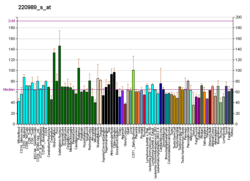Amnionless
Amnionless is a protein that in humans is encoded by the AMN gene.[5][6]
Function
A complex of amnionless and cubilin forms the cubam receptor.
The protein encoded by this gene is a type I transmembrane protein. It is thought to modulate bone morphogenetic protein (BMP) receptor function by serving as an accessory or coreceptor, and thus facilitates or hinders BMP binding. It is known that the mouse AMN gene is expressed in the extraembryonic visceral endoderm layer during gastrulation, but it is found to be mutated in amnionless mouse. The encoded protein has sequence similarity to short gastrulation (Sog) and procollagen IIA proteins in Drosophila.[6]
References
- 1 2 3 GRCh38: Ensembl release 89: ENSG00000166126 - Ensembl, May 2017
- 1 2 3 GRCm38: Ensembl release 89: ENSMUSG00000021278 - Ensembl, May 2017
- ↑ "Human PubMed Reference:".
- ↑ "Mouse PubMed Reference:".
- ↑ Kalantry S, Manning S, Haub O, Tomihara-Newberger C, Lee HG, Fangman J, Disteche CM, Manova K, Lacy E (Mar 2001). "The amnionless gene, essential for mouse gastrulation, encodes a visceral-endoderm-specific protein with an extracellular cysteine-rich domain". Nat Genet. 27 (4): 412–6. doi:10.1038/86912. PMID 11279523.
- 1 2 "Entrez Gene: AMN amnionless homolog (mouse)".
External links
- Human AMN genome location and AMN gene details page in the UCSC Genome Browser.
Further reading
- Kozyraki R, Gofflot F (2008). "Multiligand endocytosis and congenital defects: roles of cubilin, megalin and amnionless". Curr. Pharm. Des. 13 (29): 3038–46. doi:10.2174/138161207782110507. PMID 17979745.
- Wang X, Bornslaeger EA, Haub O, et al. (1996). "A candidate gene for the amnionless gastrulation stage mouse mutation encodes a TRAF-related protein". Dev. Biol. 177 (1): 274–90. doi:10.1006/dbio.1996.0162. PMID 8660894.
- Tomihara-Newberger C, Haub O, Lee HG, et al. (1999). "The amn gene product is required in extraembryonic tissues for the generation of middle primitive streak derivatives". Dev. Biol. 204 (1): 34–54. doi:10.1006/dbio.1998.9034. PMID 9851841.
- Dunn NR, Hogan BL (2001). "How does the mouse get its trunk?". Nat. Genet. 27 (4): 351–2. doi:10.1038/86829. PMID 11279507.
- Strausberg RL, Feingold EA, Grouse LH, et al. (2003). "Generation and initial analysis of more than 15,000 full-length human and mouse cDNA sequences". Proc. Natl. Acad. Sci. U.S.A. 99 (26): 16899–903. doi:10.1073/pnas.242603899. PMC 139241. PMID 12477932.
- Tanner SM, Aminoff M, Wright FA, et al. (2003). "Amnionless, essential for mouse gastrulation, is mutated in recessive hereditary megaloblastic anemia". Nat. Genet. 33 (3): 426–9. doi:10.1038/ng1098. PMID 12590260.
- Clark HF, Gurney AL, Abaya E, et al. (2003). "The secreted protein discovery initiative (SPDI), a large-scale effort to identify novel human secreted and transmembrane proteins: a bioinformatics assessment". Genome Res. 13 (10): 2265–70. doi:10.1101/gr.1293003. PMC 403697. PMID 12975309.
- Fyfe JC, Madsen M, Højrup P, et al. (2004). "The functional cobalamin (vitamin B12)-intrinsic factor receptor is a novel complex of cubilin and amnionless". Blood. 103 (5): 1573–9. doi:10.1182/blood-2003-08-2852. PMID 14576052.
- Ota T, Suzuki Y, Nishikawa T, et al. (2004). "Complete sequencing and characterization of 21,243 full-length human cDNAs". Nat. Genet. 36 (1): 40–5. doi:10.1038/ng1285. PMID 14702039.
- Tsang HT, Connell JW, Brown SE, et al. (2006). "A systematic analysis of human CHMP protein interactions: additional MIT domain-containing proteins bind to multiple components of the human ESCRT III complex". Genomics. 88 (3): 333–46. doi:10.1016/j.ygeno.2006.04.003. PMID 16730941.
This article is issued from
Wikipedia.
The text is licensed under Creative Commons - Attribution - Sharealike.
Additional terms may apply for the media files.




